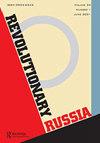Stalin. Passage to Revolution
IF 0.2
2区 历史学
Q2 HISTORY
引用次数: 0
Abstract
exchange between high and popular cultures was multidirectional, even within Russia’s highly stratified society. Innovations by artistic elites coloured the work of the newly literate, but folk and oral cultures were hugely influential on those revered for their contributions to high culture. Not only were high, middle and popular cultures in constant interaction with one another, but the interplay between them was central to the creative process. This examination of the ecosystem is particularly fruitful in chapter 3 on post-Emancipation visual culture, in which Brooks masterfully explores the contributions of the Wanderers and illustrators of cheap masscirculation (‘thin’) magazines to cultural conversations side by side. Brooks’s sensitivity to the interactions between the social, the cultural and the political makes him attuned to the anxieties related to gender that were in broad circulation amid industrialisation, urbanisation and modernisation. Brooks explores the tensions surrounding the disruption of the traditional gender order in the late nineteenth century through depictions of the vixen in popular culture, the female protagonists in the novels of Lev Tolstoy, and fantasies of male domination in The Rite of Spring. Therefore, it is disappointing that Brooks’s astuteness in analysing gendered representations does not extend across the revolutionary divide, as the New Soviet Woman and her emergence as both a protagonist (and antagonist) in the early 1920s is absent from discussions of the Soviet era. Relatedly, an analysis of sexuality does not feature in Brooks’s study. As Laura Engelstein, Dan Healey, Alison Rowley and others have shown, in the late nineteenth and early twentieth centuries, discussions and visions of sexuality reverberated across Russia’s increasingly noisy public sphere. New technologies like photography and the falling printing costs coincided with the commodification of bodies and proliferation of sexualized images in high and popular visual culture. Acknowledging these trends would have added further nuance to Brooks’s discussions of gender and power in fin-de-siècle Russia. These issues aside, The Firebird and the Fox is a rigorous and highly engaging study that brings Russian culture to life. This book was a pleasure to read and will be of interest to scholars and students of modern Russian history.斯大林。革命之路
高雅文化和通俗文化之间的交流是多向的,即使在俄罗斯高度分层的社会中也是如此。艺术精英的创新为新文学的作品增添了色彩,但民间和口头文化对那些因其对高雅文化的贡献而受到尊敬的人有着巨大的影响。不仅高级文化、中等文化和流行文化彼此之间不断互动,而且它们之间的相互作用是创作过程的核心。对生态系统的考察在第三章关于解放后的视觉文化中尤其富有成果,其中布鲁克斯巧妙地探讨了漫游者和廉价大众发行(“薄”)杂志的插图画家对文化对话的贡献。布鲁克斯对社会、文化和政治之间相互作用的敏感,使他适应了在工业化、城市化和现代化中广泛流传的与性别有关的焦虑。布鲁克斯通过对流行文化中的雌狐、列夫·托尔斯泰小说中的女性主人公以及《春之祭》中男性统治的幻想,探索了19世纪晚期传统性别秩序被破坏所带来的紧张局势。因此,令人失望的是,布鲁克斯在分析性别表征方面的敏锐并没有跨越革命的鸿沟,因为《新苏联妇女》和她在20世纪20年代初作为主角(和对手)的出现,在对苏联时代的讨论中是缺席的。与此相关的是,对性的分析并没有出现在布鲁克斯的研究中。正如劳拉·恩格尔斯坦(Laura Engelstein)、丹·希利(Dan Healey)、艾莉森·罗利(Alison Rowley)等人所表明的,在19世纪末和20世纪初,关于性的讨论和看法在俄罗斯日益嘈杂的公共领域引起了反响。摄影等新技术和印刷成本的下降与身体的商品化和高级流行视觉文化中性别化图像的扩散相吻合。认识到这些趋势,布鲁克斯对俄罗斯社会性别和权力的讨论就会更加细致入微。撇开这些问题不谈,《火鸟与狐狸》是一部严谨而引人入胜的著作,它将俄罗斯文化带入了生活。这本书读起来很有趣,对研究俄罗斯现代史的学者和学生也会有兴趣。
本文章由计算机程序翻译,如有差异,请以英文原文为准。
求助全文
约1分钟内获得全文
求助全文

 求助内容:
求助内容: 应助结果提醒方式:
应助结果提醒方式:


